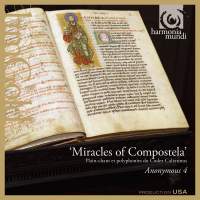Texte paru dans: / Appeared in: |
|
|
Outil de traduction |
|
|
|
|
|
Reviewer: J.
F. Weber The fifth recording of these four women from New York is as enchanting as the rest, and it was on the classical best-seller chart in Billboard as soon as my review copy arrived. A logically arranged program of medieval music like its predecessors—this selects monophonie and polyphonic music from the Codex Calixtinus to form part of the Office and Mass of St. James on the day the pilgrims arrived from all over Western Europe (July 25, still the saint's feast in the universal calendar). In quaint medieval tradition, the book is named after its supposed author, Pope Calixtus, a conceit that hasn't bothered anyone for ages. The actual title on the manuscript itself is Jacobus (James), and it can now be seen in an elegant and complete color facsimile published last year at about $3,000 (a year or two earlier the Codex Squarcialupi, equally impressive, was published at closer to $2,000 because its publication was heavily subsidized). The first music page is reproduced in the booklet. Much of the music is attributed to various authors in France, where the book originated in the middle of the twelfth century. Along with Aquitainian polyphony kept in Limoges (formerly in the library of St. Martial abbey), these bodies of polyphony antedate the earliest Notre-Dame polyphony by several decades. This program contains eleven of the polyphonic pieces (half of the total), along with four monophonie pieces previously recorded by Le Feu de Jésus or Discantus (Fanfare 18:5, p. 397 for the latter), and six monophonie chants never recorded before. This disc comes closet in content to Missa Sancii Jacobi (McGill 750037-2, issued in 1992), sung by Le Feu de Jésus Chorus in a resonant Baroque church in Montreal, a complete performance of the Mass using both monophony and polyphony without Office music. Another category of disc is the complete collection of polyphonic pieces, available only recently from Sequentia (16:2, p. 432) and Ensemble Venance Fortunát (L'Empreinte Digitale ED 13023). The complete collections of polyphony are interesting because of the simultaneous publication a couple of years ago of two transcriptions of this music, a mensural edition by Theodore Karp (16:5, p. 447) and an edition in free rhythm by Hendrik van der Werf. The polyphonic pieces are all two-voiced except for Congaudeant cat holiči (included here), which has a third voice added in a different hand. As it happens, this is the piece first and most often recorded—fourteen times between its debut in Curt Sachs's historical anthology in January 1930 and this latest version. The most readily available competitor to this disc in Sequentia's, which also has a few monophonie pieces. The ensemble on that disc is made up entirely of men, which makes the two discs neatly complementary. The interpretations are quite different, Anonymous 4 achieving an ethereal otherworldly sound in the celebrated three-voice piece while the men of Sequentia are more down-to-earth with a metrical interpretation. It's not just gender, either—the women of Discantus sing it in metrical rhythm and sound more like Sequentia. This great work alone makes the new disc the choice item among Calixtine issues that I've heard. On the other hand, I am not sympathetic with the odd metrical rhythm that Anonymous 4 brings to the contrafactum on the familiar hymn Salve festa dies (it's not very satisfactory in the only other version, either, the one by Le Feu de Jésus). While the text-setting to the old melody doesn't match the hymn of Venantius Fortunatus exactly, I'd expect the contrafactum to be sung rather more like the original, which was greatly familiar to everyone who would sing the hymn. Susan Hellauer writes a notably intelligent commentary furnished with texts and translations in a large booklet slipcased with the jewelbox. The sound captured in the Campion Center (also used for their second disc) is just as fine as Boxgrove Priory yielded last time. What a blessing it is to have such a choice of interpretations as Jacobus now enjoys.
| |
|
|
|
|
|
|
|
Cliquez l'un ou l'autre
bouton pour découvrir bien d'autres critiques de CD |
|




